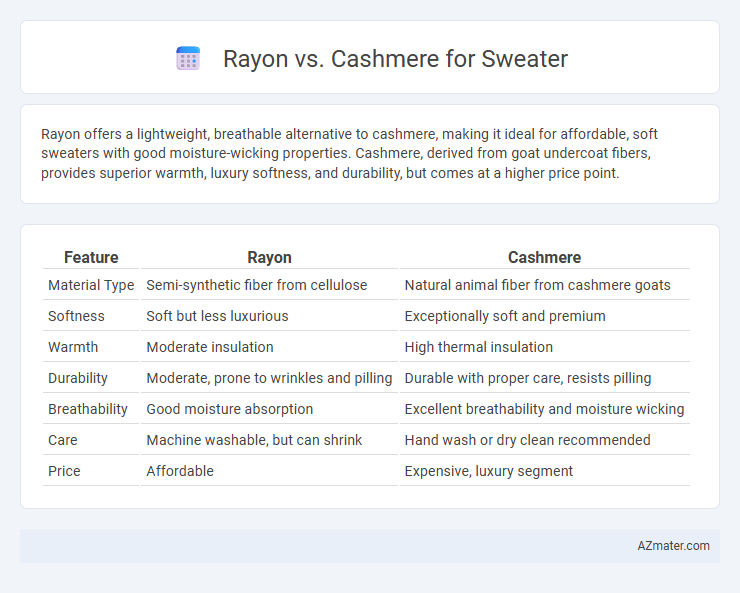Rayon offers a lightweight, breathable alternative to cashmere, making it ideal for affordable, soft sweaters with good moisture-wicking properties. Cashmere, derived from goat undercoat fibers, provides superior warmth, luxury softness, and durability, but comes at a higher price point.
Table of Comparison
| Feature | Rayon | Cashmere |
|---|---|---|
| Material Type | Semi-synthetic fiber from cellulose | Natural animal fiber from cashmere goats |
| Softness | Soft but less luxurious | Exceptionally soft and premium |
| Warmth | Moderate insulation | High thermal insulation |
| Durability | Moderate, prone to wrinkles and pilling | Durable with proper care, resists pilling |
| Breathability | Good moisture absorption | Excellent breathability and moisture wicking |
| Care | Machine washable, but can shrink | Hand wash or dry clean recommended |
| Price | Affordable | Expensive, luxury segment |
Introduction to Rayon and Cashmere
Rayon is a semi-synthetic fiber made from regenerated cellulose, known for its softness, breathability, and affordability, making it a popular choice for lightweight sweaters. Cashmere, derived from the fine undercoat of Cashmere goats, is prized for its exceptional warmth, luxurious softness, and natural insulation properties. Both fibers offer distinct advantages in sweater fabric, with rayon providing easy-care versatility and cashmere delivering premium comfort and elegance.
Origin and Production Processes
Rayon is a semi-synthetic fiber derived from cellulose found in wood pulp, primarily produced through chemical processes like viscose or modal methods, offering affordability and versatility. Cashmere originates from the undercoat of Cashmere goats, mainly from regions such as Mongolia, China, and Nepal, harvested through meticulous hand-combing or shearing that ensures softness and luxury. The production of rayon involves large-scale industrial processing with chemical treatments, while cashmere emphasizes sustainable animal fiber collection and meticulous quality control for premium textiles.
Texture and Feel: Comparing Comfort
Rayon sweaters offer a smooth, lightweight texture that mimics natural fibers, providing breathable comfort ideal for mild climates. Cashmere is renowned for its ultra-soft, luxurious feel, delivering superior warmth and a gentle touch against the skin. While rayon tends to have a silky finish, cashmere excels in plushness and insulating properties, making it preferred for premium sweater comfort.
Warmth and Insulation Properties
Cashmere offers superior warmth and insulation compared to rayon due to its natural fine fibers that trap heat efficiently, making it ideal for cold-weather sweaters. Rayon, a semi-synthetic fabric, lacks the dense fiber structure of cashmere, resulting in less effective heat retention and insulation. Cashmere sweaters provide better moisture-wicking and breathability, enhancing comfort while maintaining warmth in chilly conditions.
Breathability and Moisture Management
Cashmere offers excellent breathability and natural moisture-wicking properties, making it ideal for regulating body temperature and maintaining comfort in sweaters. Rayon, while soft and smooth, tends to trap moisture and lacks the same level of breathability, which can lead to discomfort in humid conditions. Sweaters made from cashmere outperform rayon in moisture management, ensuring dryness and enhanced wearability during varied weather.
Durability and Longevity
Cashmere sweaters offer superior durability and longevity compared to rayon due to their natural fiber composition, which resists pilling and maintains softness over time. Rayon, a semi-synthetic fiber, tends to degrade faster with frequent washing and wear, often losing shape and texture after multiple uses. Investing in cashmere ensures a long-lasting sweater that retains warmth and aesthetic appeal through years of regular use.
Maintenance and Care Requirements
Rayon sweaters require gentle washing by hand or using a delicate cycle with cold water to prevent shrinking and maintain softness, while cashmere sweaters demand even more meticulous care, including hand washing with specialized cashmere detergent or dry cleaning to preserve fiber integrity and softness. Both fabrics should be dried flat to avoid stretching, though cashmere fibers are particularly prone to damage from heat and rough handling. Proper storage in breathable garment bags or folded in drawers helps prevent moth damage to cashmere and maintains rayon's texture over time.
Sustainability and Environmental Impact
Cashmere production often leads to overgrazing, causing desertification and significant environmental degradation, while rayon manufacturing involves chemical-intensive processes that can result in water pollution if not managed properly. Sustainable rayon options, such as those derived from certified sustainably sourced wood pulp, offer a lower environmental footprint compared to conventional viscose, whereas cashmere's high demand exacerbates ecological strain on fragile ecosystems. Choosing eco-friendly rayon blends prioritizes responsible resource use and reduced chemical waste, making it a more sustainable alternative to traditional cashmere sweaters.
Cost Comparison and Value for Money
Rayon sweaters generally cost significantly less than cashmere, making them a budget-friendly option for those seeking soft fabric without the high price tag. Cashmere offers superior warmth, durability, and luxurious softness, justifying its higher price with long-term value and comfort. Investing in cashmere can be more cost-effective over time due to its longevity and timeless appeal compared to the cheaper, less durable rayon.
Choosing the Right Sweater Material
Rayon offers a lightweight and breathable option for sweaters, ideal for moderate climates and budget-conscious buyers seeking a silk-like texture. Cashmere provides superior warmth, softness, and durability, making it a premium choice for cold weather and luxurious comfort. Selecting between rayon and cashmere depends on factors like climate, desired texture, and maintenance preferences, with cashmere requiring more delicate care compared to the easier upkeep of rayon.

Infographic: Rayon vs Cashmere for Sweater
 azmater.com
azmater.com